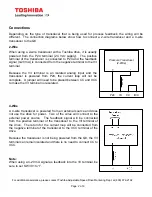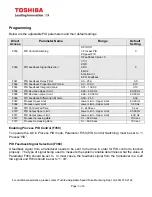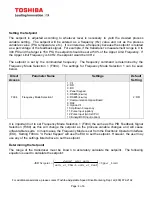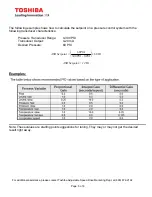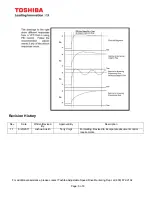
For additional assistance, please contact Toshiba Adjustable Speed Drive Marketing Dept. at (800) 872-2192
Page: 4 of 6
Setting the Setpoint
The setpoint is adjusted according to whatever level is necessary to yield the desired process
variable setting. The setpoint will be entered as a frequency (Hz) value and not as the process
variable’s value (PSI, temperature, etc.). It is entered as a frequency because the setpoint is related
as a percentage of the feedback signal. For example, if the transducer’s measurement range is 0 to
300 PSI and the target is 150 PSI, the setpoint should be set at 50% of the Upper Limit Frequency. If
the Upper Limit Frequency is 60 Hz, the setpoint would be 30 Hz.
The setpoint is set by the commanded frequency. The frequency command is determined by the
Frequency Mode Selection 1 (F004). The settings for Frequency Mode Selection 1 can be seen
below.
Direct
Access
Parameter Name
Settings
Default
Setting
F004
Frequency Mode Selection 1
1: V/I
2: RR
3: RX
4: Panel Keypad
5: RS485 (2-wire)
6: RS485 (4-wire)
7: Communication Option Board
8: RX2
9: Option V/I
10: Up/Down Frequency
11: Pulse Input (option)
12: Pulse Input (motor CPU)
13: Binary/BCD Input (option)
2: RR
It is important not to set Frequency Mode Selection 1 (F004) the same as the PID Feedback Signal
Selection (F360) as this will change the setpoint as the process variable changes and will cause
unfavorable results. In most cases, the Frequency Mode is set from the Electronic Operator Interface
(EOI). Setting F004 to “4: Panel Keypad” will use the EOI to set the setpoint. However, the user may
use any of the settings listed above to set the setpoint.
Determining the Setpoint
The range of the transducer must be known to accurately calculate the setpoint. The following
equation is used to calculate the setpoint:
ASD Setpoint
Limit
Upper
mA
at
units
mA
at
units
units
setpt
desired
_
4
_
_
20
_
_
_
_


